The document discusses constructors in Java, highlighting their role in initializing objects, types (default and parameterized), and methods of object creation. It also covers method and constructor overloading, including examples, and explains static members, allowing access to class members without instantiating objects. Additional exercises for practice on these concepts are also provided.
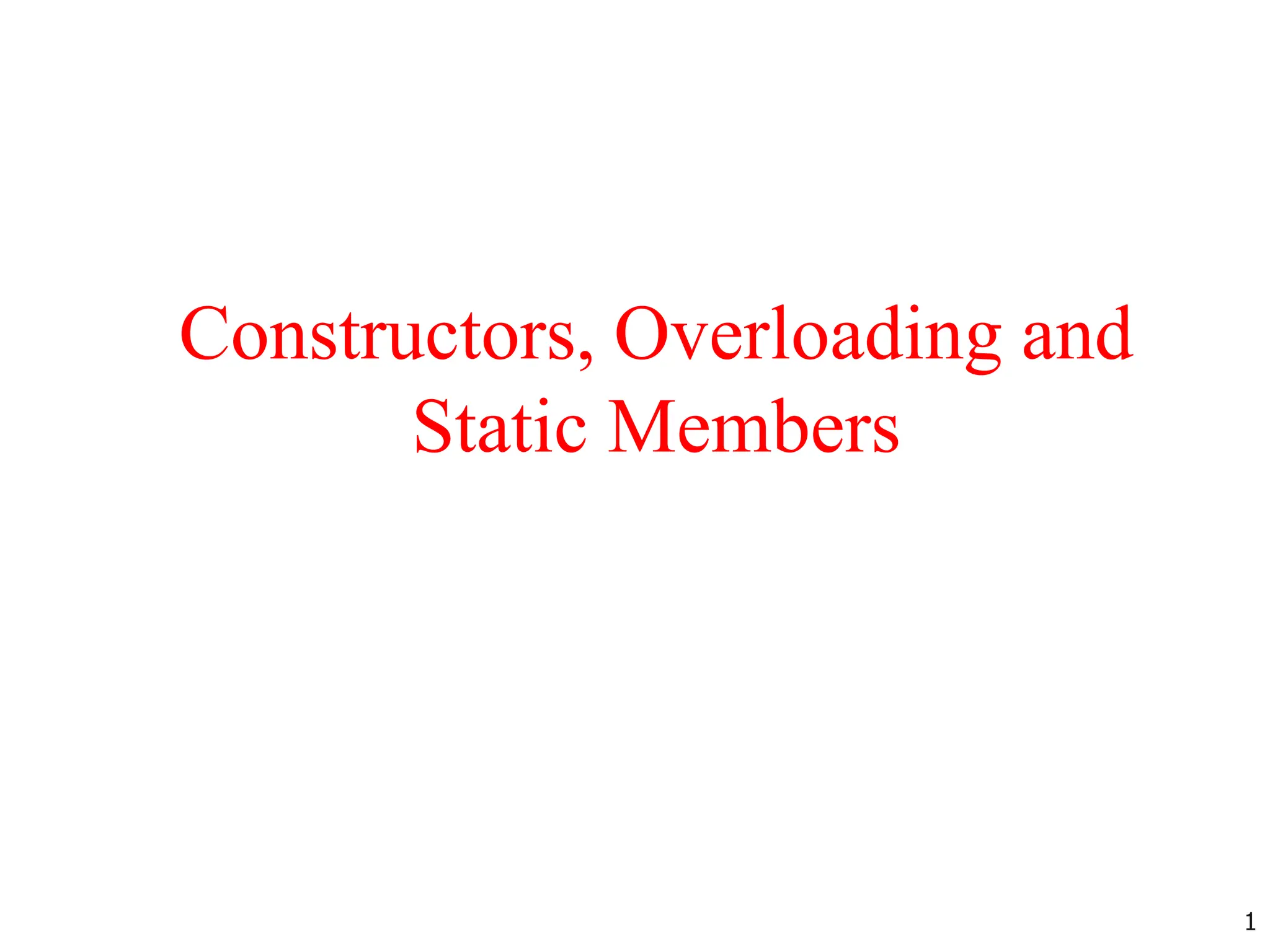
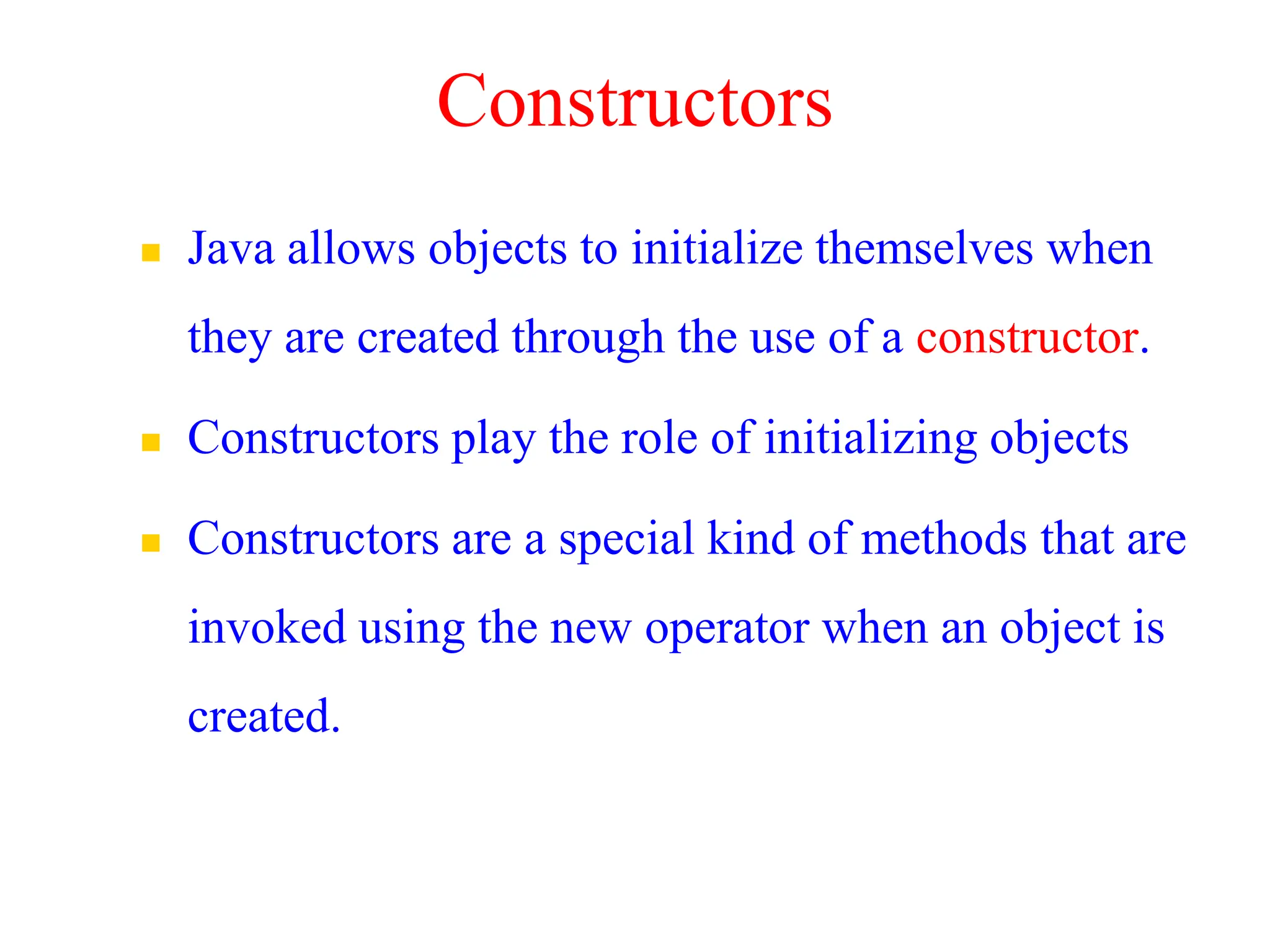
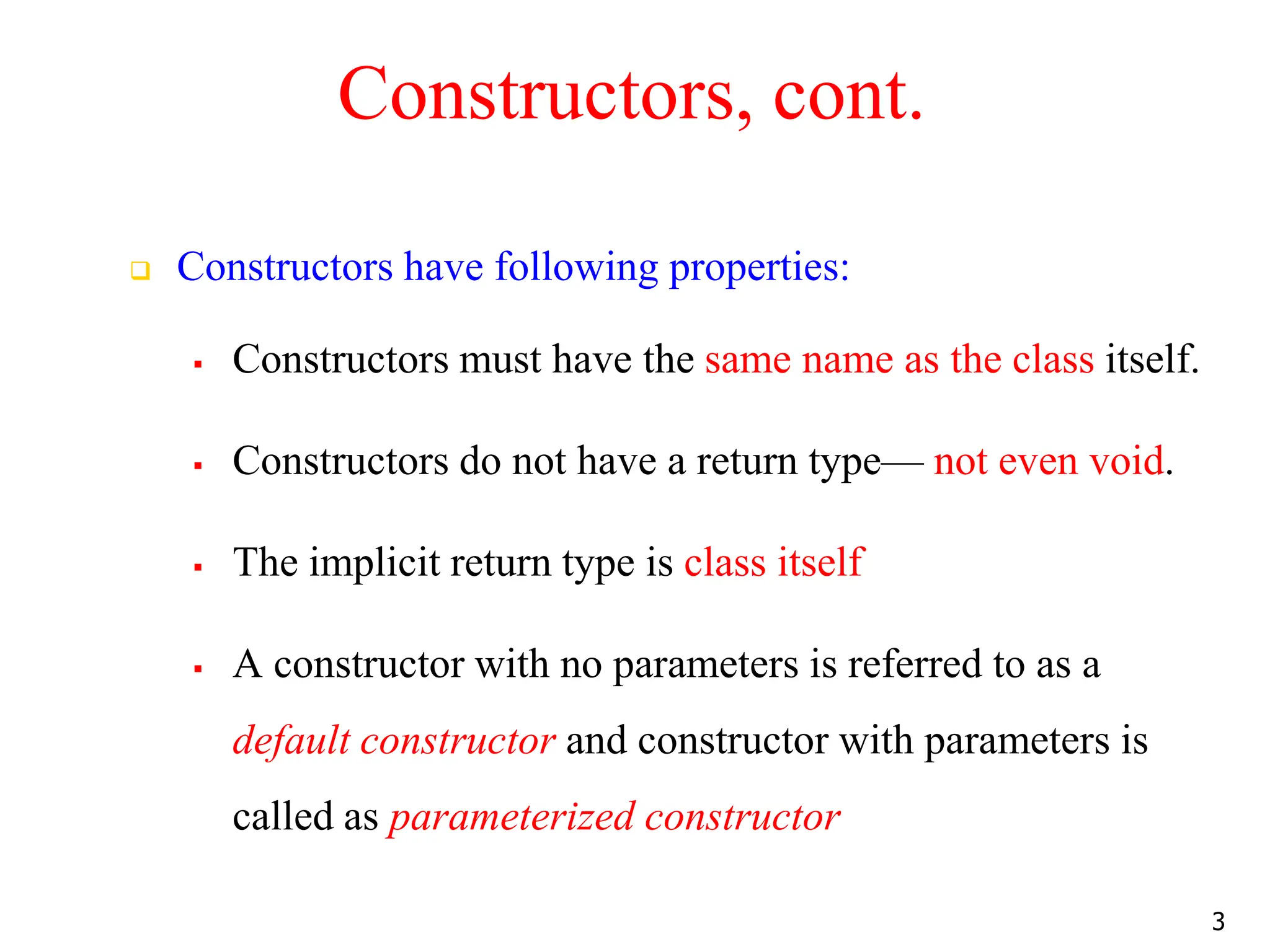
![Program for constructor class Box { double width; double height; double depth; // This is the constructor for Box. Box() { System.out.println("Constructing Box"); width = 10; height = 10; depth = 10; } // compute and return volume double volume() { return width * height * depth; } } class BoxDemo1 { public static void main(String args[]) { // declare, allocate, and initialize Box objects Box mybox1 = new Box(); //constructor invoked Box mybox2 = new Box(); //constructor invoked double vol; // get volume of first box vol = mybox1.volume(); System.out.println("Volume is " + vol); // get volume of second box vol = mybox2.volume(); System.out.println("Volume is " + vol); } } 4](https://image.slidesharecdn.com/session3notes-240628063727-68fde05e/75/Session-3-Constructors-Types-Overloading-Static-MethodsNotes-pdf-4-2048.jpg)
![Parameterized Constructors class Box { double width; double height; double depth; // This is the constructor for Box. Box(double w, double h, double d) { width = w; height = h; depth = d; } // compute and return volume double volume() { return width * height * depth; } } class BoxDemo2 { public static void main(String args[]) { // declare, allocate, and initialize Box objects Box mybox1 = new Box(10, 20, 15); Box mybox2 = new Box(3, 6, 9); double vol; // get volume of first box vol = mybox1.volume(); System.out.println("Volume is " + vol); // get volume of second box vol = mybox2.volume(); System.out.println("Volume is " + vol); } } 5](https://image.slidesharecdn.com/session3notes-240628063727-68fde05e/75/Session-3-Constructors-Types-Overloading-Static-MethodsNotes-pdf-5-2048.jpg)
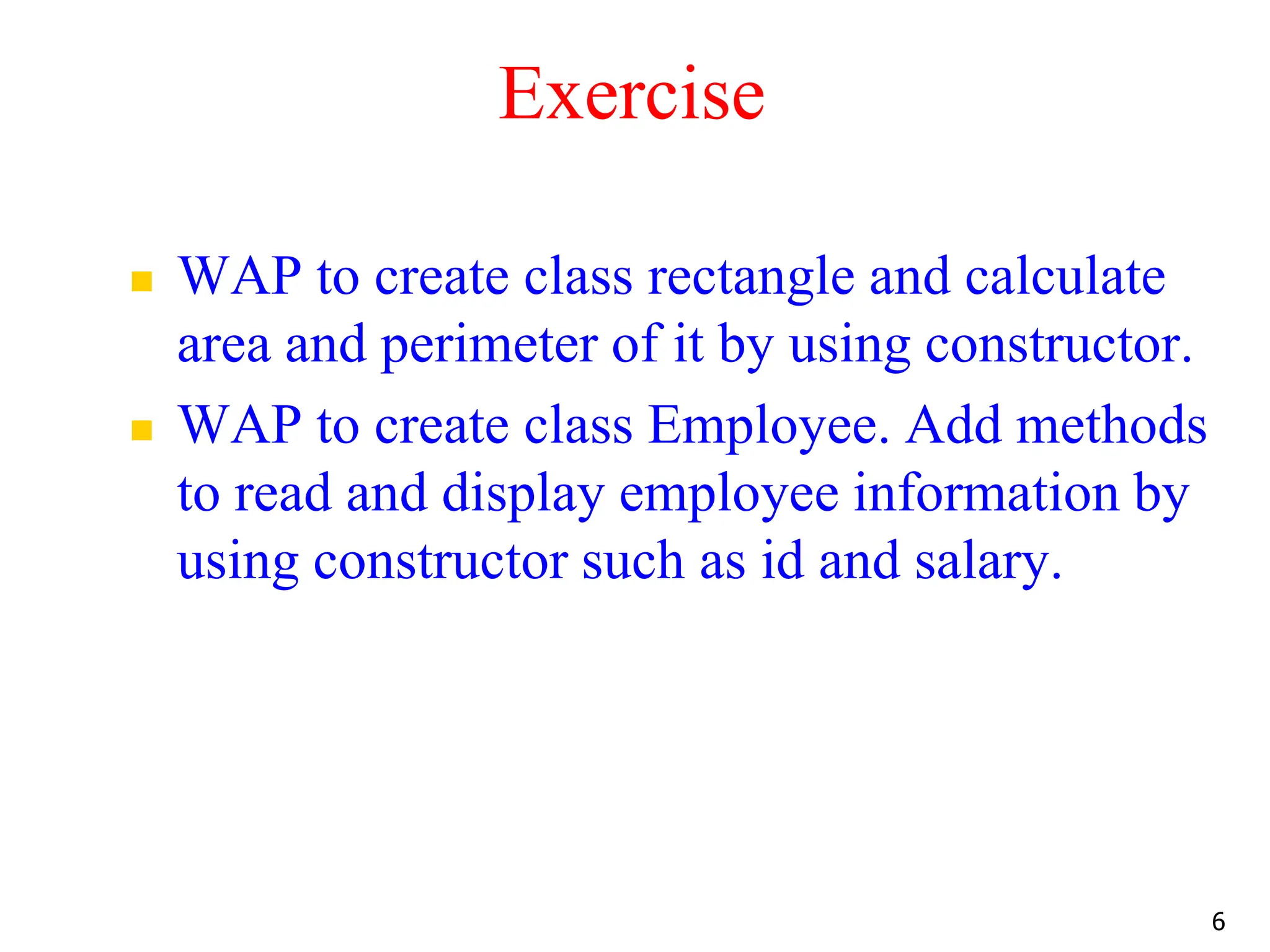
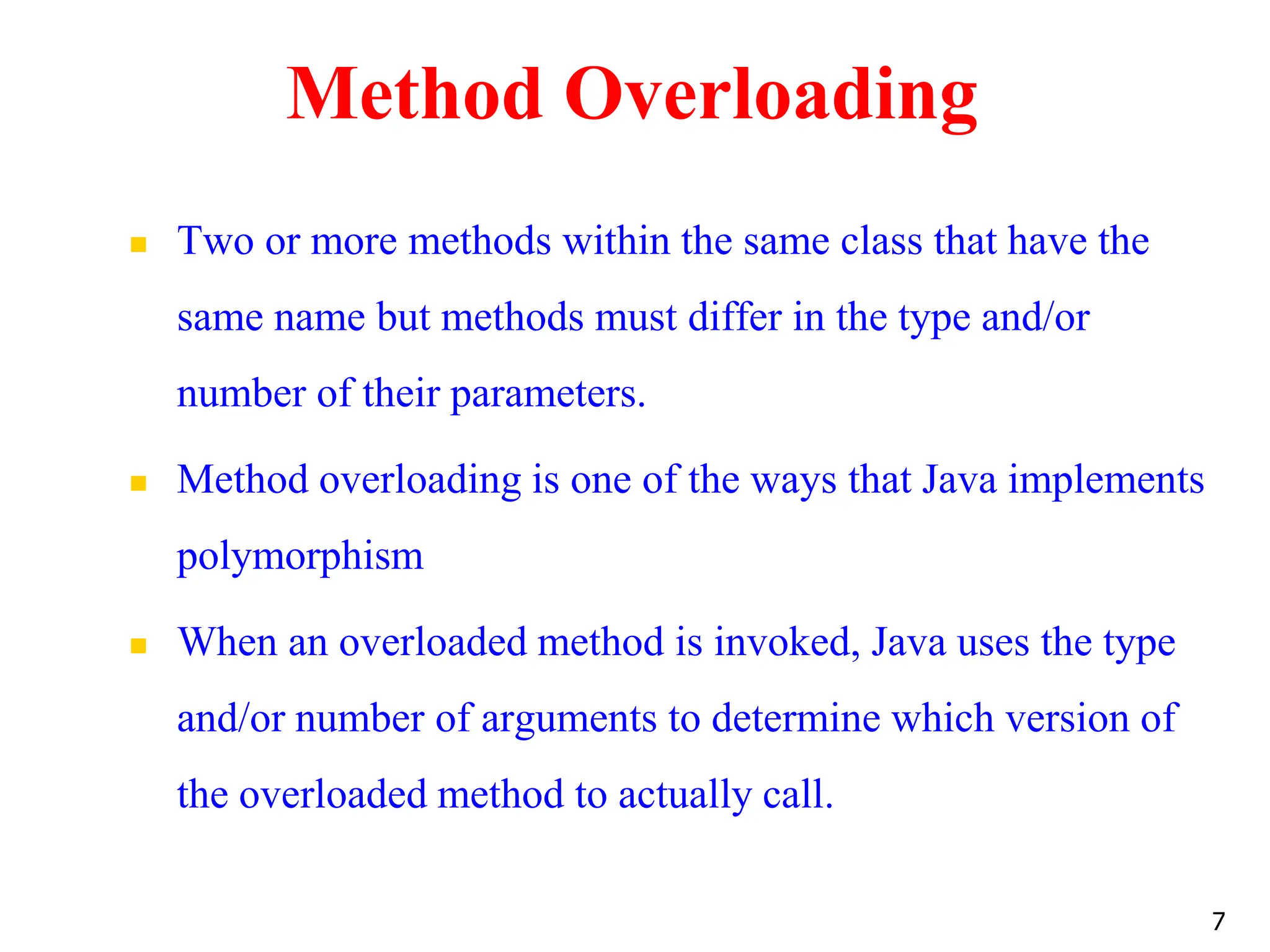
![Example class OverloadDemo { void test() { System.out.println("No parameters"); } void test(int a) { System.out.println("a: " + a); } void test(int a, int b) { System.out.println("a and b: " + a + " " + b); } double test(double a) { System.out.println("double a: " + a); return a*a; } } class Overload { public static void main(String args[]) { OverloadDemo ob = new OverloadDemo(); double result; // call all versions of test() ob.test(); ob.test(10); ob.test(10, 20); result = ob.test(123.2); System.out.println("Result of ob.test(123.2): " + result); } } 8](https://image.slidesharecdn.com/session3notes-240628063727-68fde05e/75/Session-3-Constructors-Types-Overloading-Static-MethodsNotes-pdf-8-2048.jpg)
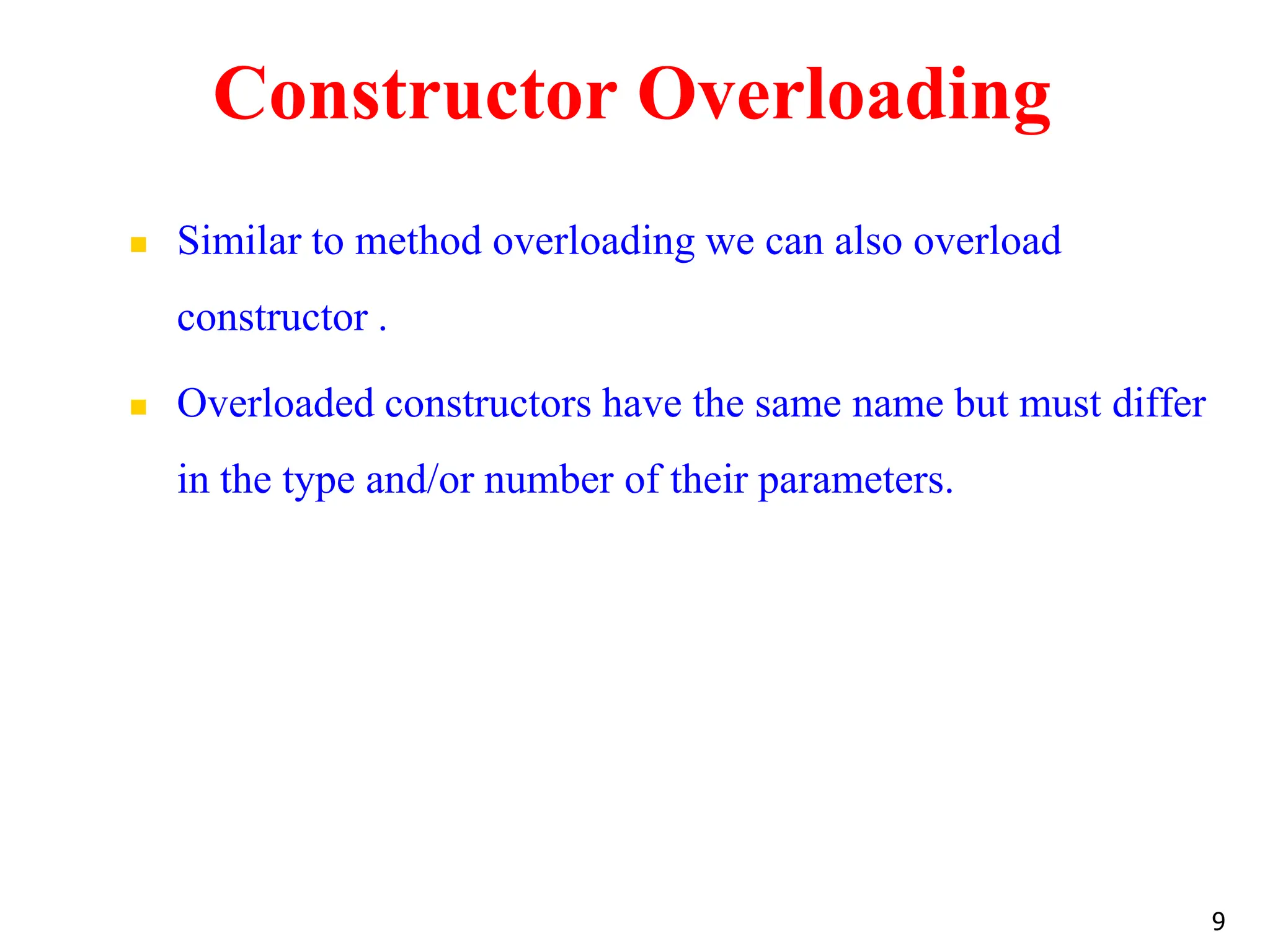
![Example class Box { double width; double height; double depth; // constructor used when all dimensions specified Box(double w, double h, double d) { width = w; height = h; depth = d; } // constructor used when no dimensions specified Box() { width = -1; // use -1 to indicate height = -1; // an uninitialized depth = -1; // box } // constructor used when cube is created Box(double len) { width = height = depth = len; } // compute and return volume double volume() { return width * height * depth; } class OverloadCons { public static void main(String args[]) { // create boxes using the various constructors Box mybox1 = new Box(10, 20, 15); Box mybox2 = new Box(); Box mycube = new Box(7); double vol; // get volume of first box vol = mybox1.volume(); System.out.println("Volume of mybox1 is " + vol); // get volume of second box vol = mybox2.volume(); System.out.println("Volume of mybox2 is " + vol); // get volume of cube vol = mycube.volume(); System.out.println("Volume of mycube is " + vol); } } 10](https://image.slidesharecdn.com/session3notes-240628063727-68fde05e/75/Session-3-Constructors-Types-Overloading-Static-MethodsNotes-pdf-10-2048.jpg)
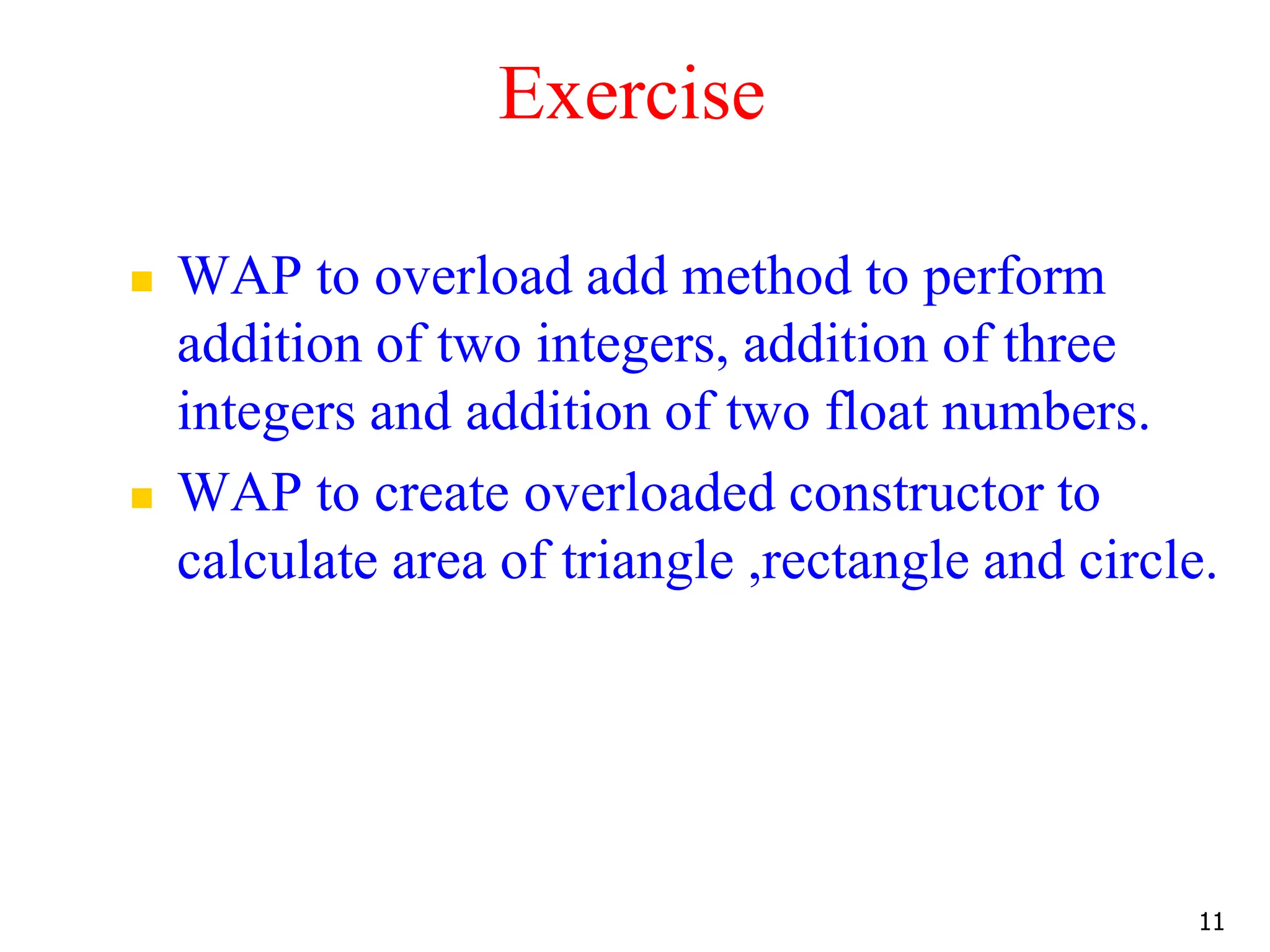
![Using Objects as Parameters class Test { int a, b; Test(int i, int j) { a = i; b = j; } void add(Test o) { if(o.a == a && o.b == b) System.out.println(" Equal”); else System.out.println(" Not Equal”); } } class PassOb { public static void main(String args[]) { Test ob1 = new Test(100, 22); Test ob2 = new Test(100, 22); Test ob3 = new Test(-1, -1); ob1.equals(ob2)); ob1.equals(ob3)); } } 12](https://image.slidesharecdn.com/session3notes-240628063727-68fde05e/75/Session-3-Constructors-Types-Overloading-Static-MethodsNotes-pdf-12-2048.jpg)
![Returning Object class Test { int a ,b; Test() { a = 0; b=0; } Test(int i ,int j) { a = i; b=j; } Test add() { Test temp = new Test(); temp.a=a+10; temp.b=b+10; return temp; }} class RetOb { public static void main(String args[]) { Test ob1 = new Test(2 ,4); Test ob2; ob2 = ob1.add(); System.out.println("ob1.a: " + ob1.a); System.out.println("ob1.b: " + ob1.b); System.out.println("After Addition :"); System.out.println("ob2.a: " + ob2.a); System.out.println("ob2.b: " + ob2.b); } } 13](https://image.slidesharecdn.com/session3notes-240628063727-68fde05e/75/Session-3-Constructors-Types-Overloading-Static-MethodsNotes-pdf-13-2048.jpg)
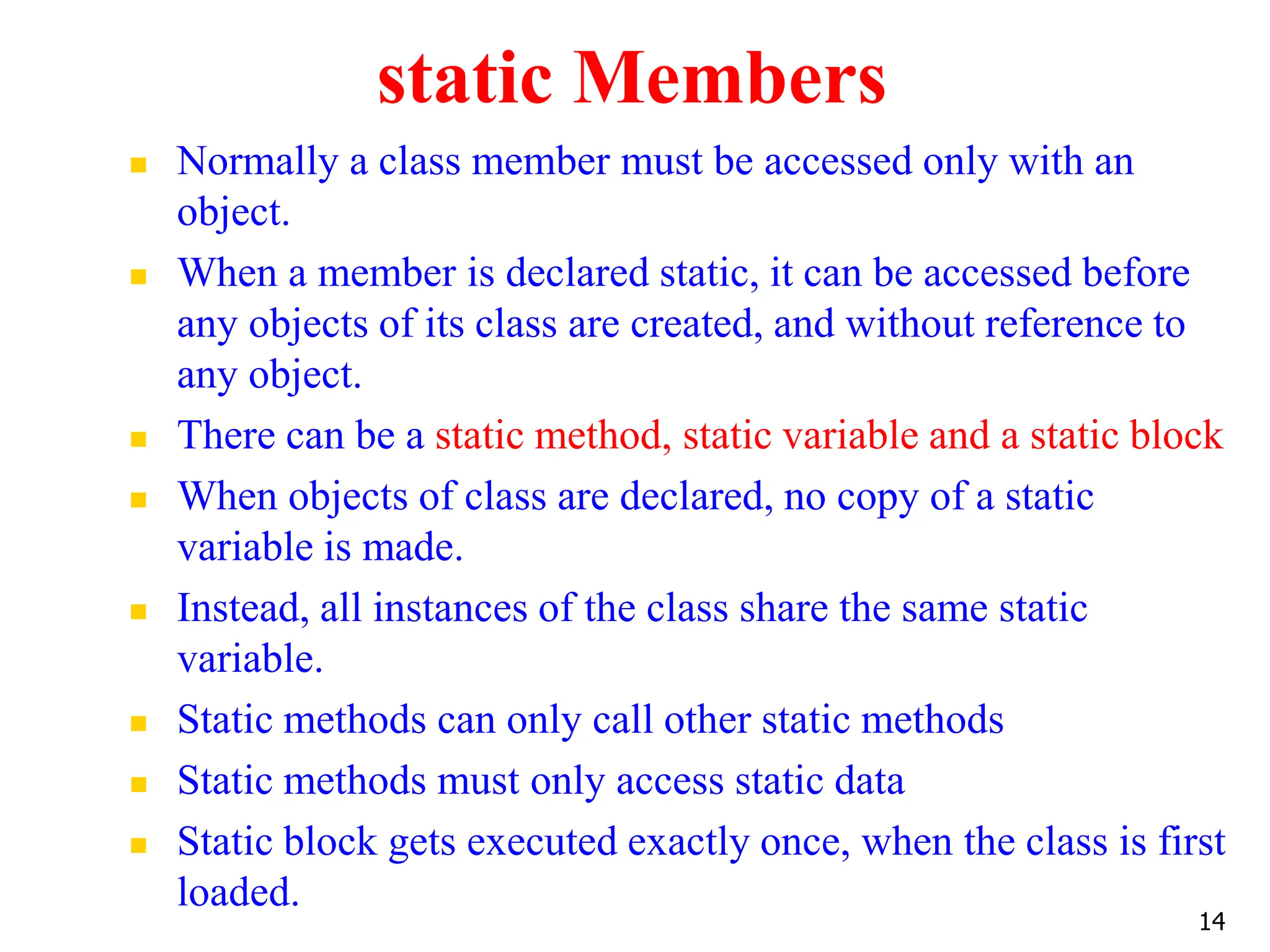
![class UseStatic { static int a = 3; static int b; static void meth(int x) { System.out.println("x = " + x); System.out.println("a = " + a); System.out.println("b = " + b); } static { System.out.println("Static block initialized."); b = a * 4; } public static void main(String args[]) { meth(42); }} OUTPUT Static block initialized. x = 42 a = 3 b = 12 15](https://image.slidesharecdn.com/session3notes-240628063727-68fde05e/75/Session-3-Constructors-Types-Overloading-Static-MethodsNotes-pdf-15-2048.jpg)
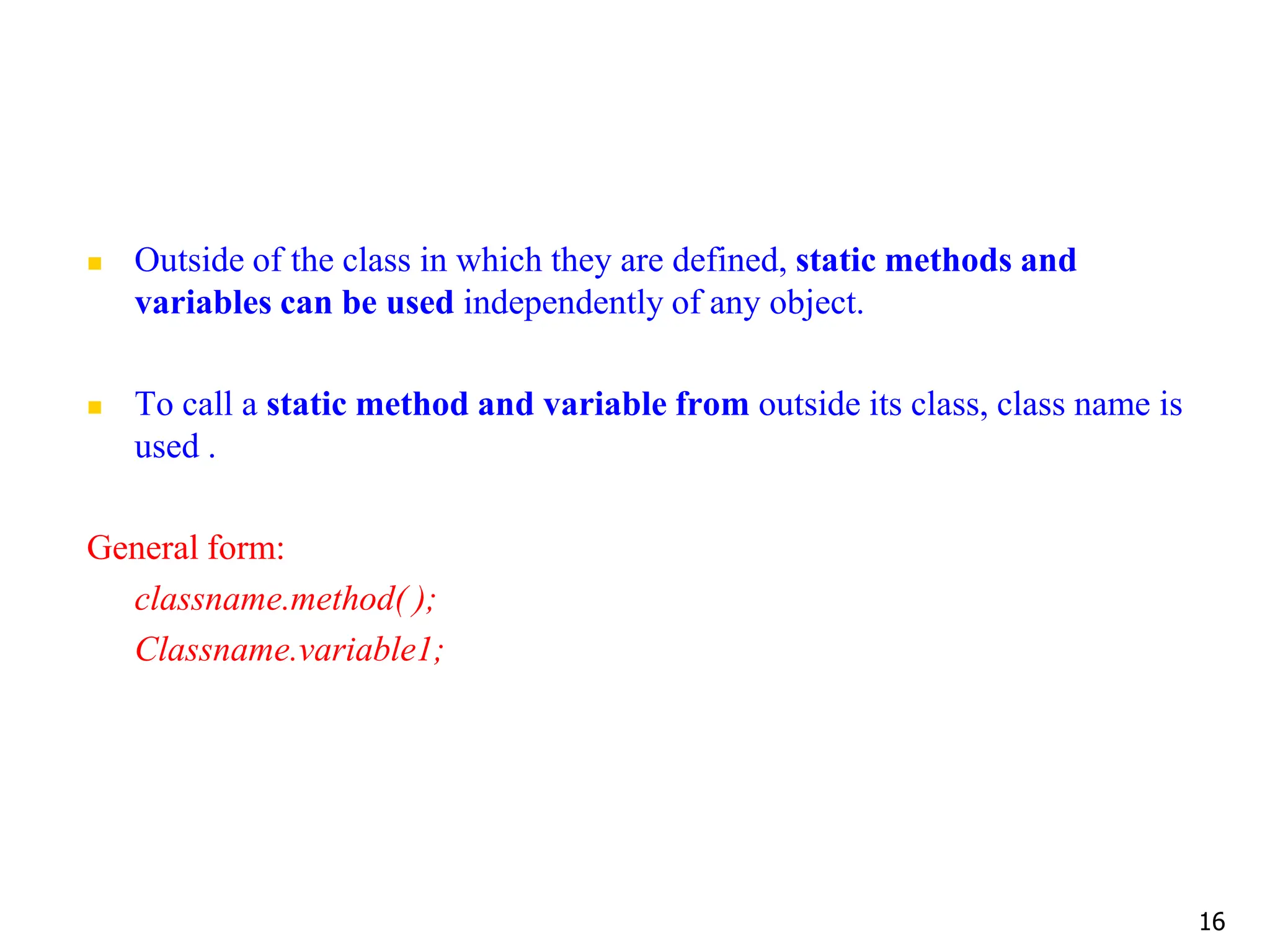
![class StaticDemo { static int a = 42; static int b = 99; static void callme() { System.out.println("a = " + a); } } class StaticByName { public static void main(String args[]) { StaticDemo.callme(); System.out.println("b = " + StaticDemo.b); } } output : a = 42 b = 99 17](https://image.slidesharecdn.com/session3notes-240628063727-68fde05e/75/Session-3-Constructors-Types-Overloading-Static-MethodsNotes-pdf-17-2048.jpg)